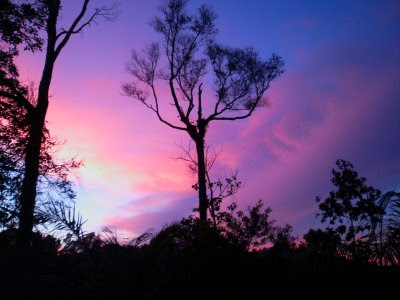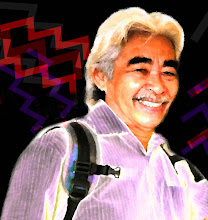
Wednesday, December 31, 2008
Morning Mist
 This is the view of the Kemena River very early in the morning, around 7.30 am with the morning mist having a light cover over the river. The small river craft to the right is called ' kapel tambang' which ferries the Kampung Jepak folks to work to the town proper everyday.
This is the view of the Kemena River very early in the morning, around 7.30 am with the morning mist having a light cover over the river. The small river craft to the right is called ' kapel tambang' which ferries the Kampung Jepak folks to work to the town proper everyday.An adult is charged RM.50 per crossing. Ahead of the 'kapel tambang' is a small ferry that carries the kampung folks who ride motorycles to work. This morning the river is at low tide.
 On the way out of my farm the other day, I was met by a heavy cover of morning mist though the time was about 7.00 am. The above view is taken before reaching the Kemena Bridge.
On the way out of my farm the other day, I was met by a heavy cover of morning mist though the time was about 7.00 am. The above view is taken before reaching the Kemena Bridge.
Labels:
Kemena River transportation,
River scenes,
Weather
Bamboo for cooking vessel

The kind of food that is stuffed inside these young bamboo stems are like glutinous rice, chicken meat or fish. At the Bintulu tamu yesterday I saw them being sold at RM 1 a piece.
In the hot and humid tropical rainforest of Bintulu , bamboos are a very important forest resource. The ways of using bamboo are very much left to imagination. Bamboos are used to build all parts of a house except the roof, where thatched palm leaves are the preference. There are made into suspension bridges, scaffoldings to reach dizzly heights to harvest bird's nest on the ceiling of caves, river rafts, furniture, handicrafts ( e.g. coin box,baskets,table mats,chopsticks, walking sticks, etc) and young bamboo buds are eaten as vegetables, so called ' bamboo shoots'. Bamboos are the tallest of all grasses, reaching 30 meters and more. And as seen in Chinese movies you can jump and run on top of bamboo trees to execute your kung fu kicks:)))
Sunday, December 28, 2008
Edible Seeds of the 'Cempedak'
 I had a fun time climbing the 'cempedak' tree today. The 'cempedak' fruit( artocarpus integer) is very much akin to the jackfruit( artocarpus heterophyllus). There are at least 5 trees that are fruiting profusely at my farm currently. The cempedak fruit is consumed in three main ways. In the above picture, its yellowish flesh which has a soft, custard-like texture can be eaten fresh. It can also be boiled with coconut milk and sugar to make 'dodol'. On the right of the picture, the seeds of the cempedak have been boiled and are ready to be eaten, preferably with honey. In Sarawak and therefore Bintulu for that matter, the fruiting season for cempedak is between the months of November right till February every year.
I had a fun time climbing the 'cempedak' tree today. The 'cempedak' fruit( artocarpus integer) is very much akin to the jackfruit( artocarpus heterophyllus). There are at least 5 trees that are fruiting profusely at my farm currently. The cempedak fruit is consumed in three main ways. In the above picture, its yellowish flesh which has a soft, custard-like texture can be eaten fresh. It can also be boiled with coconut milk and sugar to make 'dodol'. On the right of the picture, the seeds of the cempedak have been boiled and are ready to be eaten, preferably with honey. In Sarawak and therefore Bintulu for that matter, the fruiting season for cempedak is between the months of November right till February every year.Silhouettes in Sunset
Friday, December 26, 2008
A Typical December
 This year December is without doubt the wettest month of Bintulu. As I face the closing days of the year here I would like to post this picture of a view from my computer table of a typical December day. Sitting behind this huge window, I blog and get in touch with the wide wide world. Well, staying in a farm has its merits. The evergreen wash of colours over the fields is kind to the eyes.The abundance of oxygen that exudes the daily air from the tons of leaves are nature's gift to a healthy lung. The multitudes of wildlife become my companion and give much moral support to the projects that get stranded due to the heavy rains. We cannot push nature to the extremes and living in my eco-farm is like learning to live in harmony with nature. The song of the birds delights my senses as much as my spirit. The presence of wildlife jolts my soul to nature's joy of living. And the quietness of night gives me comfort after the bustle of daylight . Another day to celebrate with the rise of dawn.
This year December is without doubt the wettest month of Bintulu. As I face the closing days of the year here I would like to post this picture of a view from my computer table of a typical December day. Sitting behind this huge window, I blog and get in touch with the wide wide world. Well, staying in a farm has its merits. The evergreen wash of colours over the fields is kind to the eyes.The abundance of oxygen that exudes the daily air from the tons of leaves are nature's gift to a healthy lung. The multitudes of wildlife become my companion and give much moral support to the projects that get stranded due to the heavy rains. We cannot push nature to the extremes and living in my eco-farm is like learning to live in harmony with nature. The song of the birds delights my senses as much as my spirit. The presence of wildlife jolts my soul to nature's joy of living. And the quietness of night gives me comfort after the bustle of daylight . Another day to celebrate with the rise of dawn.Thursday, December 25, 2008
Speed boats by Bintulu's river
 Just the other day while passing the Kampung Baru village, I saw these twin-powered 200 horsepower speed boats moored by the Sebiew river,Bintulu. These boats are normally used to go offshore by timber merchants or traders to inspect their logs before loading into foreign timber ships that are anchored about 10 - 15 km off Bintulu coast. They are also rented by tourists and deep sea fishing enthusiasts to offshore fishing spots some 75-100 km away to sea. Tourists use them to cruise the Bintulu coastline or to upriver for outboard riding.
Just the other day while passing the Kampung Baru village, I saw these twin-powered 200 horsepower speed boats moored by the Sebiew river,Bintulu. These boats are normally used to go offshore by timber merchants or traders to inspect their logs before loading into foreign timber ships that are anchored about 10 - 15 km off Bintulu coast. They are also rented by tourists and deep sea fishing enthusiasts to offshore fishing spots some 75-100 km away to sea. Tourists use them to cruise the Bintulu coastline or to upriver for outboard riding.Tuesday, December 16, 2008
Bintulu's Hardest Wood
 It is called the 'Belian' ( Eusideroxylon zwageri ) .The locals here have no doubts to its longevity and resistance to insects attack or rot. Pressed further they will say that their lives revolve around it. Belian timber are made into roofing tiles or shingles, floors, jetties, house posts, fences, steps and stairs, walkways, pestles and mortars, weapons, canoe hulls, telephone and electricity posts, stakes for pepper vines or piles for civil construction. It is so useful to the peoples of Sarawak that it is prohibitted to be exported. At this sawmill ,you can buy or order to size the timber from as thick as 30 cm to as thin as 4mm, normally the size used for roofing shingles. The belian timber is heavy and therefore will sink when placed in water or river. But when submerged for say half a century or more like the ones used as posts for village houses along Bintulu river, they are not subjected to rot. Strange but true.
It is called the 'Belian' ( Eusideroxylon zwageri ) .The locals here have no doubts to its longevity and resistance to insects attack or rot. Pressed further they will say that their lives revolve around it. Belian timber are made into roofing tiles or shingles, floors, jetties, house posts, fences, steps and stairs, walkways, pestles and mortars, weapons, canoe hulls, telephone and electricity posts, stakes for pepper vines or piles for civil construction. It is so useful to the peoples of Sarawak that it is prohibitted to be exported. At this sawmill ,you can buy or order to size the timber from as thick as 30 cm to as thin as 4mm, normally the size used for roofing shingles. The belian timber is heavy and therefore will sink when placed in water or river. But when submerged for say half a century or more like the ones used as posts for village houses along Bintulu river, they are not subjected to rot. Strange but true.First Facts of Bintulu - First Garden Gazebo
This is the best picture I have of the first garden structure built at a public space and for public amenity in Bintulu in the very early years of the 1960's. The structure was probably built in 1960. The roof was made of tiles and post of belian hardwood. The floor was tiled with mosaic . This public amenity was well frequented in those days and around it were other public amenities like the see-saw and swing. The garden lawn was planted with cow grass ( axonopus compressus) and the most interesting feature was that it was planted with trees. One particular tree that still remains to this day is the yellow flame tree ( Peltophorum pterocarpum) ( Please see picture below) which is fortunately preserved in the re-making of the park and its surrounding area which is underway now.
To the left of the yellow flame tree was a swing, which I used to play with and towards the right would be the public structure or gazebo. In 1961, I was 10 years old. Thus this tree is more than 45 years old now.
The center of attraction of the park today is this fountain. However, there are no rest or garden shelter built like it used to be before.
Farm road wet as a river
The above scene is typical of Bintulu these days. Since my arrival here last Friday, it has been raining everyday, if not in the day it will surely rain at night. This morning while on the way out to fetch my worker I was met with heavy downpour that made the earth road slippery and negotiating up the steep hilly slope a tricky adventure. But I managed only because I used a 4x4 vehicle.
For Sarawak, the months of November to January are referred to as the 'Landas' season or the rainy monsoon season. The term monsoon was made popular by Arab traders who found that two monsoons a year come to tropical Asia bringing in solid downpour of rain in different places at different times. In Arabic 'musim' means season. For example the North Easterly winds that blow through the months of November till January will result in torrentious rain for Sarawak, Borneo, Sumatra and Java. While the South westerly winds will wet the areas of India, Thailand and the western parts of Peninsular Malaysia.
Subscribe to:
Posts (Atom)












